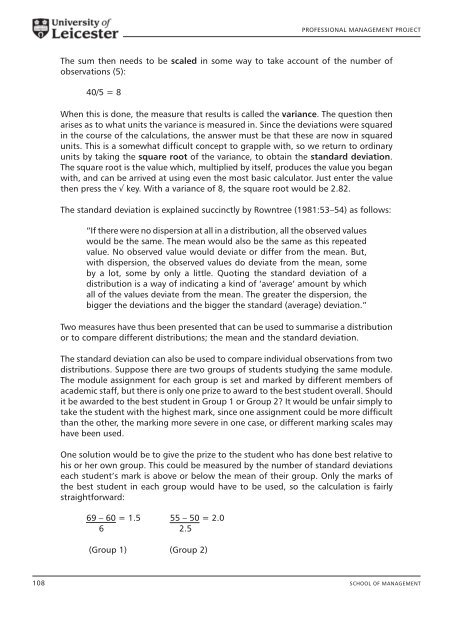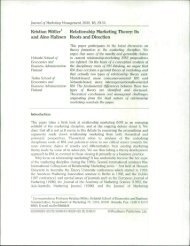PMP module book final.pdf - Blackboard - University of Leicester
PMP module book final.pdf - Blackboard - University of Leicester
PMP module book final.pdf - Blackboard - University of Leicester
Create successful ePaper yourself
Turn your PDF publications into a flip-book with our unique Google optimized e-Paper software.
PROFESSIONAL MANAGEMENT PROJECT<br />
The sum then needs to be scaled in some way to take account <strong>of</strong> the number <strong>of</strong><br />
observations (5):<br />
40/5 = 8<br />
When this is done, the measure that results is called the variance. The question then<br />
arises as to what units the variance is measured in. Since the deviations were squared<br />
in the course <strong>of</strong> the calculations, the answer must be that these are now in squared<br />
units. This is a somewhat difficult concept to grapple with, so we return to ordinary<br />
units by taking the square root <strong>of</strong> the variance, to obtain the standard deviation.<br />
The square root is the value which, multiplied by itself, produces the value you began<br />
with, and can be arrived at using even the most basic calculator. Just enter the value<br />
then press the √ key. With a variance <strong>of</strong> 8, the square root would be 2.82.<br />
The standard deviation is explained succinctly by Rowntree (1981:53–54) as follows:<br />
“If there were no dispersion at all in a distribution, all the observed values<br />
would be the same. The mean would also be the same as this repeated<br />
value. No observed value would deviate or differ from the mean. But,<br />
with dispersion, the observed values do deviate from the mean, some<br />
by a lot, some by only a little. Quoting the standard deviation <strong>of</strong> a<br />
distribution is a way <strong>of</strong> indicating a kind <strong>of</strong> ‘average’ amount by which<br />
all <strong>of</strong> the values deviate from the mean. The greater the dispersion, the<br />
bigger the deviations and the bigger the standard (average) deviation.”<br />
Two measures have thus been presented that can be used to summarise a distribution<br />
or to compare different distributions; the mean and the standard deviation.<br />
The standard deviation can also be used to compare individual observations from two<br />
distributions. Suppose there are two groups <strong>of</strong> students studying the same <strong>module</strong>.<br />
The <strong>module</strong> assignment for each group is set and marked by different members <strong>of</strong><br />
academic staff, but there is only one prize to award to the best student overall. Should<br />
it be awarded to the best student in Group 1 or Group 2? It would be unfair simply to<br />
take the student with the highest mark, since one assignment could be more difficult<br />
than the other, the marking more severe in one case, or different marking scales may<br />
have been used.<br />
One solution would be to give the prize to the student who has done best relative to<br />
his or her own group. This could be measured by the number <strong>of</strong> standard deviations<br />
each student’s mark is above or below the mean <strong>of</strong> their group. Only the marks <strong>of</strong><br />
the best student in each group would have to be used, so the calculation is fairly<br />
straightforward:<br />
69 – 60 = 1.5 55 – 50 = 2.0<br />
6 2.5<br />
(Group 1) (Group 2)<br />
108 SChOOL OF MANAGEMENT






